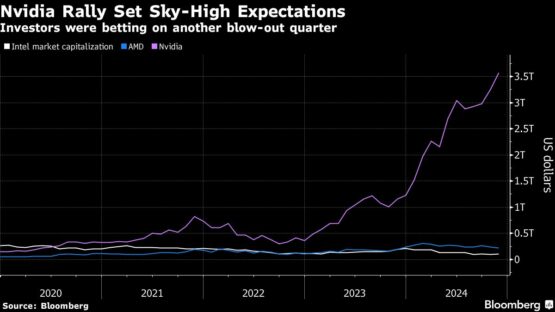Nvidia Confirms New Chip Progress Despite Disappointing Forecast
Nvidia Corp has reassured investors that its new product range is set to sustain the company’s AI-driven growth trajectory, although the urgent need to expedite chip delivery is resulting in higher-than-expected costs.
During a discussion following the quarterly earnings announcement, Chief Executive Officer Jensen Huang stated that Nvidia’s highly anticipated Blackwell products are scheduled for release this quarter, supported by “very strong” demand. However, the production and engineering expenses for these chips are expected to impact profit margins, and Nvidia’s sales outlook for the current period fell short of some of Wall Street’s more optimistic forecasts.
ADVERTISEMENT
CONTINUE READING BELOW
This led to a lukewarm response from investors, who had pushed Nvidia shares up nearly 200% this year prior to the earnings report. Following such a remarkable rally, which positioned the chipmaker as the most valuable company in the world, any outcome less than stellar was bound to disappoint. The shares fell by about 4% in premarket trading.
Nvidia anticipates fiscal fourth-quarter sales of approximately $37.5 billion. While the average analyst forecast is $37.1 billion, estimates have been as high as $41 billion.
“The guidance suggests lower growth, but it could indicate Nvidia is being cautious,” remarked Alvin Nguyen, an analyst at Forrester Research Inc. “In the short term, there’s no concern regarding AI demand. Nvidia is undertaking all necessary actions.”

The company’s primary revenue driver is its accelerator chip, which enhances the development of AI models by processing vast amounts of data. Since the release of OpenAI’s ChatGPT in 2022, the demand for this product has surged.
Wall Street has been closely monitoring the rollout of Blackwell, the latest addition to this category, which boasts greater speed and improved compatibility with other semiconductors. Manufacturing hurdles have delayed the launch, and Nvidia reiterated concerns regarding supply constraints on Wednesday. Demand is anticipated to surpass supply for several quarters.
“Key concerns revolve around the production rate for Blackwell and customer concentration,” noted Emarketer analyst Jacob Bourne. “There’s little margin for error in execution for 2025.”
According to Huang, Blackwell is now in “full production,” and there remains interest in Hopper, the previous model. “Blackwell is currently with all our major partners,” he stated on the conference call.
However, transitioning to Blackwell has affected profit margins. The company’s gross margin, which indicates the percentage of sales remaining after production costs, is projected to drop to around 73% this quarter, down from 75% previously. This figure is expected to rebound as new products reach larger-scale production and the economics improve.
When asked if Nvidia’s gross margin could return to mid-70s levels by mid-next year, Chief Financial Officer Colette Kress indicated that this is a plausible expectation. Nvidia’s margin is significantly higher than its competitors: Advanced Micro Devices Inc. has a gross margin about 20 percentage points lower, and Intel Corp.’s margin falls well below Nvidia’s.
The growth Nvidia has experienced over the last two years is remarkable. Its revenue is on track to double for a second consecutive year, now generating more profit than it previously earned in total revenue.
Nvidia’s revenue surged 94% to $35.1 billion in the fiscal third quarter, which ended on October 27. Excluding certain factors, profit was reported at 81 cents a share. Analysts had anticipated revenue of about $33.25 billion and earnings of 74 cents per share.
ADVERTISEMENT:
CONTINUE READING BELOW
Nvidia’s largest division, the data center unit, saw revenue double compared to the previous year, reaching $30.8 billion. This figure exceeded Wall Street’s forecasts.
However, networking revenue within this segment dropped sequentially, and the business is increasingly reliant on a limited number of customers: cloud service providers. This group, which includes major players like Microsoft Corp and Amazon.com’s AWS, represented 50% of data center revenue, rising from 45% in the preceding period.
Investors prefer that figure to decrease, signaling that AI usage is becoming more widespread throughout the economy.
Other recent earnings reports have shown encouraging signs for AI. Nvidia’s clients, such as Microsoft, Amazon, and Meta Platforms, have reiterated their plans to invest heavily in AI infrastructure.
Nvidia has only fallen short of analysts’ revenue expectations once in the last five years. It has frequently exceeded expectations by as much as 20% in recent quarters, establishing a high benchmark for its performance.
Its data center division alone now generates more revenue than the combined totals of rivals Intel and AMD. This year, Nvidia’s net income is expected to surpass Intel’s revenue, a company that was once the largest player in the chip industry for decades.
Nvidia initially gained recognition for selling graphics processors but quickly realized that its technology also has significant applications for AI. Its chips assist software models during the training phase, where they learn to identify and react to real-world stimuli. Nvidia’s components are also utilized in systems that run the software—known as inference—which helps power services like ChatGPT.
Based in Santa Clara, California, the company has swiftly broadened its product range to encompass networking, software, services, and fully integrated computer systems. Huang is actively traveling worldwide to advocate for broader adoption of his technology among corporations and government agencies.
“The era of AI has arrived, and it is vast and diverse,” Huang proclaimed.
© 2024 Bloomberg
Follow Moneyweb’s in-depth finance and business news on WhatsApp here.




